Navigating the next 46 months of Trump
Donald Trump’s second term was expected to reignite the market strategy of his first – corporate tax cuts, deregulation, and a pro-business stance.(1) While Trump’s first term saw significant trade policies, particularly the US-China trade war and NAFTA (North American Free Trade Agreement) renegotiation,(2) his second term has escalated protectionism at a much faster pace,(3) with tariffs and trade barriers implemented more abruptly. While the broader US exceptionalism thesis remains intact, the pace and sequencing of policy execution have shifted, creating early volatility but ultimately aligning with pro-growth objectives.(4)
Key takeaways
- US exceptionalism remains a key factor: While policy shifts and tariffs have introduced new challenges, the US continues to hold structural advantages that support long-term resilience.
- Policy-driven shifts: Rapid tariff escalation and deregulation have altered market dynamics, creating both near-term disruptions and long-term opportunities in key sectors.
- Sector positioning matters: Defensive sectors like healthcare, financials, and industrials are well-positioned to provide resilience, while small and mid-cap stocks stand to benefit from domestic policy tailwinds.
Why market reactions are different this time
Markets are reacting differently to Trump’s second term, not because the US exceptionalism thesis has changed, but due to the speed and nature of policy execution. In his first term, policies were introduced gradually – tariffs were phased in, tax cuts were immediate but well-telegraphed, and deregulation was implemented over time. Markets had time to adjust and price in these changes.(5)
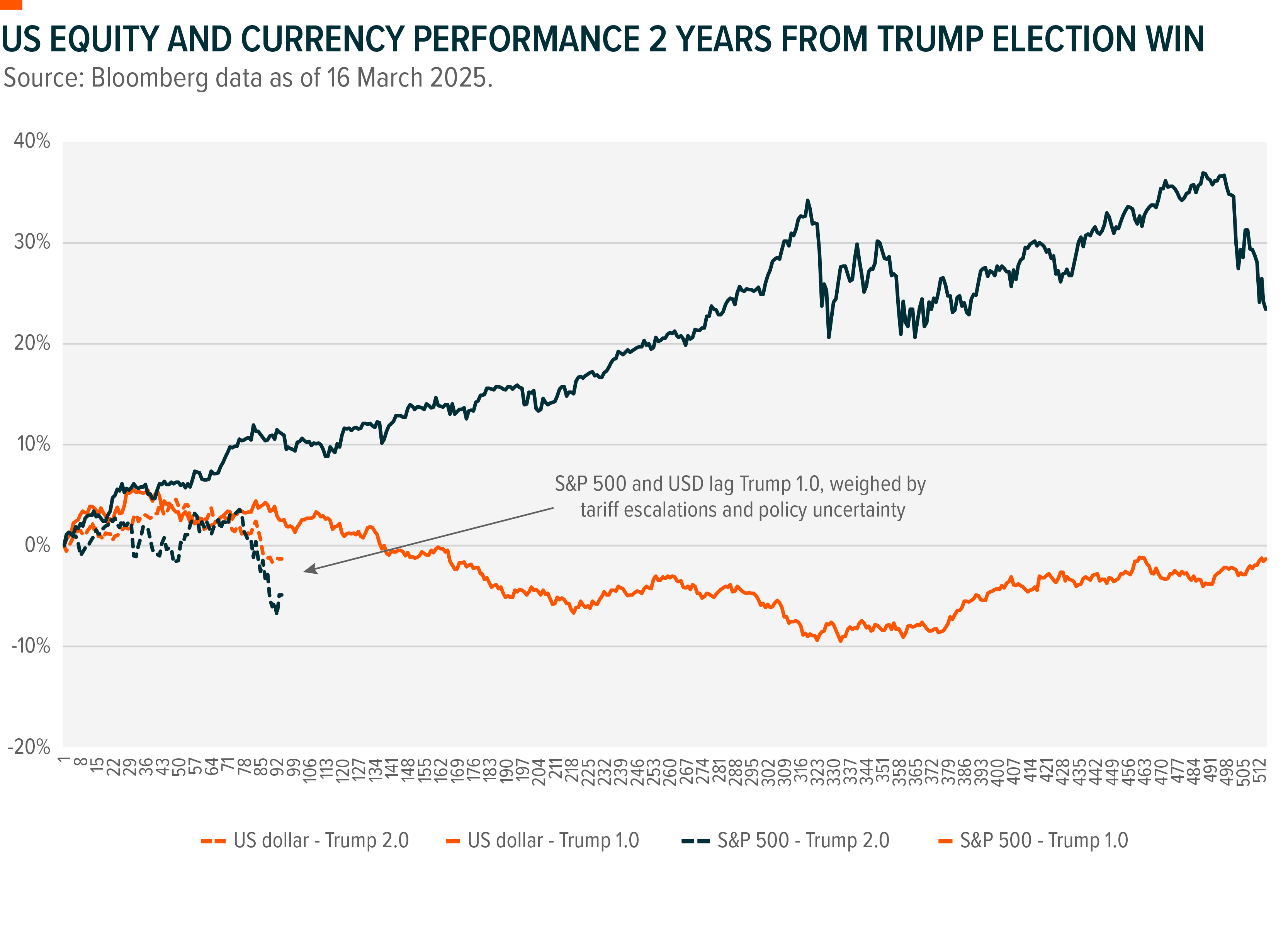
This time, key policies have been enacted in rapid succession. Within weeks, the administration imposed sweeping tariffs on Canada, Mexico, and China, issued an executive order loosening financial regulations to accelerate capital return potential for banks, fast-tracked defence and infrastructure spending to boost key industrial sectors, and signalled additional tax incentives aimed specifically at domestic manufacturers.(6) This compressed timeline has front-loaded uncertainty and volatility, evidenced by the S&P 500 and the US dollar both underperforming compared to Trump’s first term, weighed down by heightened policy uncertainty and rapid tariff escalation.
Additionally, tariffs have proved heavier and their projected economic impact more persistent than initially anticipated, resulting in moderated short-term US growth expectations.(7) Markets have historically underestimated the long-term impact of rapid policy shifts, and current volatility may follow the same pattern. As policy implementation stabilises, markets are likely to recalibrate and realign with the administration’s underlying pro-growth stance and long-term economic objectives.
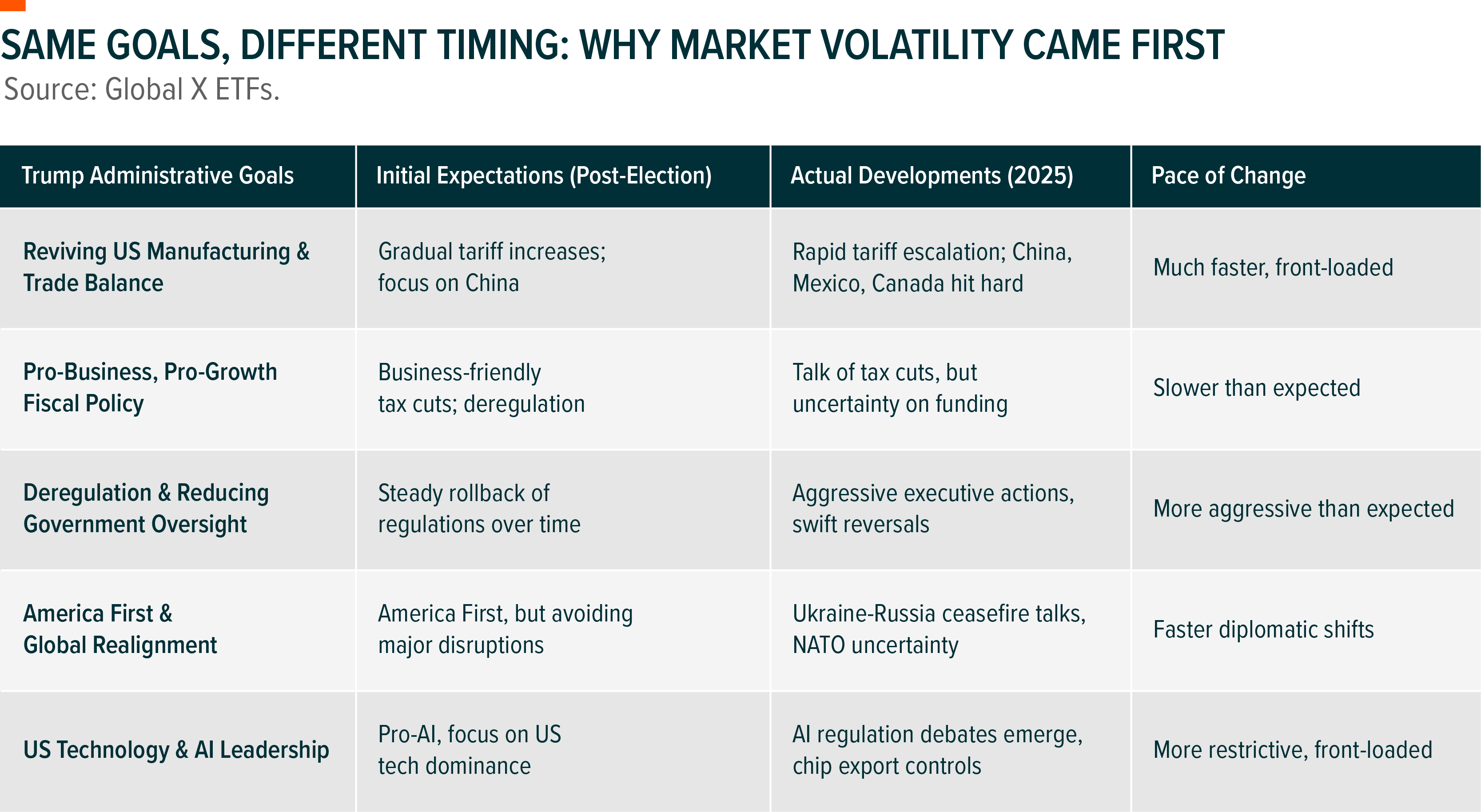
Where the upside lies
While US economic fundamentals remain resilient, near-term growth expectations have weakened as tariffs weigh on key industries. While analysts expect a rebound in late 2025, execution risk remains high.
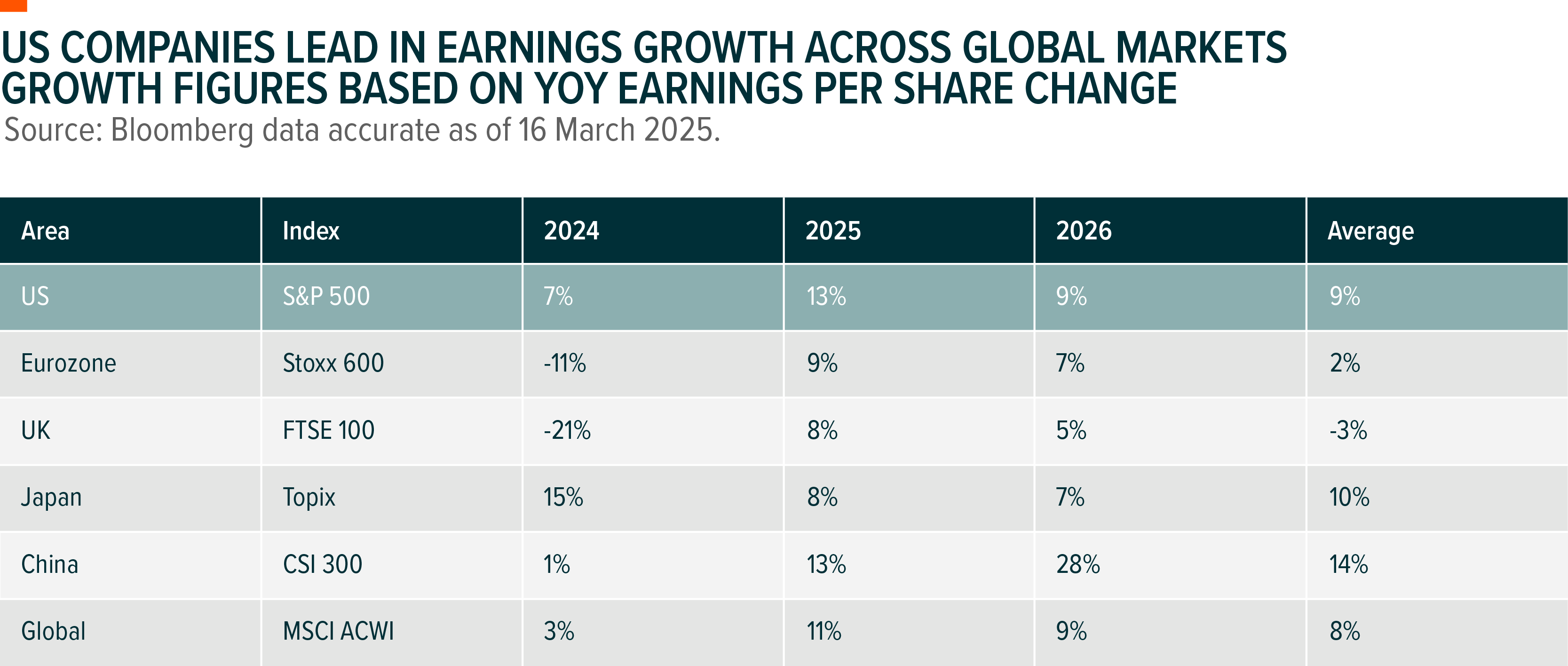
Dividend growth is playing a bigger role in driving fundamental returns than many may realise accounting for 43% of the combined year-on-year growth in earnings per share and dividends across S&P 500 sectors (as of 16 March 2025). In this context, we define ‘stacked growth’ as the sum of EPS growth and dividend growth – a breakdown of two key components of shareholder value creation. This approach helps highlight what’s driving sector performance beneath the surface.
Recent regulatory shifts, including reduced capital requirements for banks and accelerated permitting for industrial projects, have improved capital efficiency and strengthened the outlook for future earnings and capital return. Meanwhile, Q4 2025 earnings expectations remain intact, suggesting growth is delayed rather than lost. Sector dispersion remains notable, with consumer discretionary and financials showing the strongest combined earnings and dividend growth.
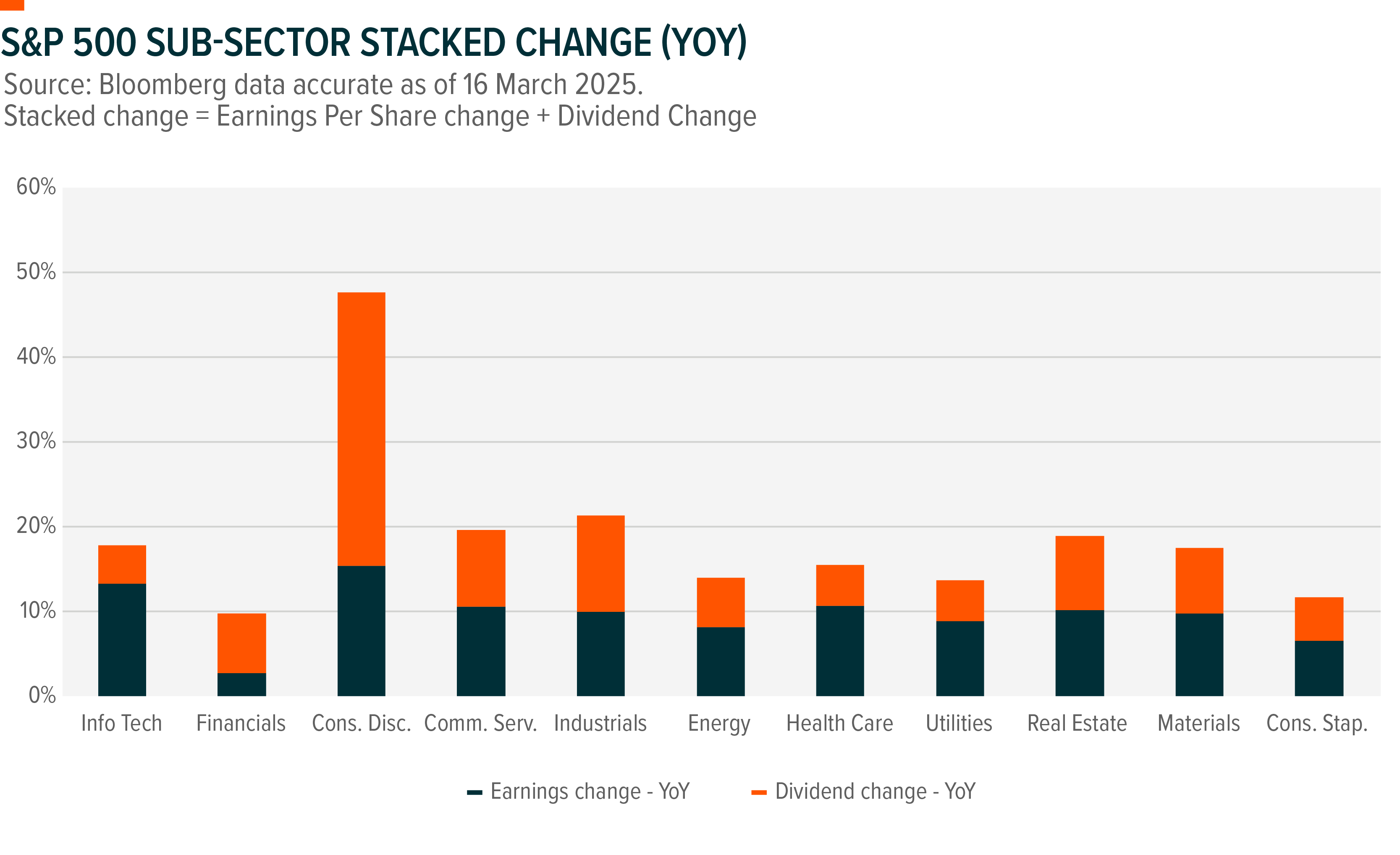
Forecasts are not guaranteed, and undue reliance should not be placed on them. This information is based on views as at 16/03/2025.
Equities: A shift in leadership
Market leadership is recalibrating as investors digest Trump’s rapid policy implementation. Expectations of a broad-based pro-business rally have shifted toward selective sector opportunities. Industrials and infrastructure firms stand to gain significantly from deregulation, domestic manufacturing incentives, and increased government spending.(8) Financials, buoyed by deregulation, now find themselves uniquely positioned to deliver most of their growth from strong shareholder returns through dividends and buybacks.
Tariffs have weighed on some small and mid-cap stocks, but tax incentives and deregulation could offset these pressures as policy execution unfolds. Historically, small-cap stocks outperform during economic expansions and periods of rate-cutting scenarios likely given current policy trajectories highlighting their longer-term appeal within a domestic-focused US growth strategy.(9)
Given ongoing volatility, investors are increasingly recognising the importance of defensive positioning. Sectors traditionally viewed as defensive, including consumer staples, healthcare, industrials, and utilities, are particularly well-positioned to provide resilience. These sectors offer strategic opportunities for investors seeking stability amid ongoing volatility and reduced exposure to tech-heavy sectors.
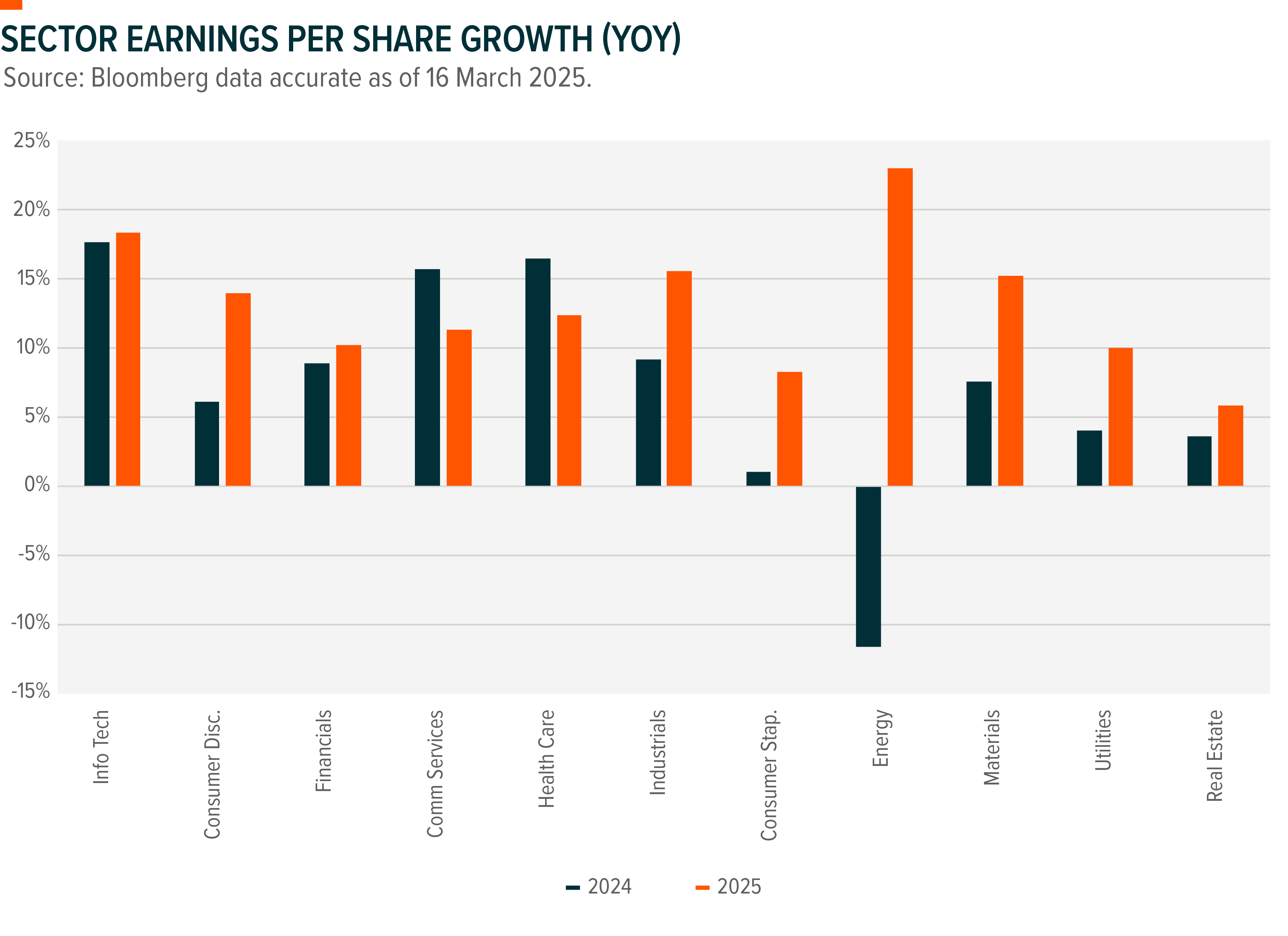
Reassessing US exceptionalism: A strategic approach, not blind optimism
Ultimately, US exceptionalism remains a key foundation for investment decisions, but its trajectory will depend on whether policy execution can balance pro-growth initiatives with ongoing volatility. The resilience of the US market is demonstrated through its ability to absorb policy-induced volatility while maintaining structural economic advantages. Although short-term uncertainties prevail, the convergence of earnings growth between mega-cap leaders and the broader market signals a healthy diversification, offering long-term stability.(10)
Investors acknowledging the intersection of policy tailwinds, sector-specific dynamics, and resilient fundamentals will find themselves well-positioned to capture future market upside. Despite near-term volatility, structural trends indicate opportunity rather than prolonged market distress, underscoring the strategic strength of US exceptionalism as it evolves through Trump’s second term. If there’s one thing I’ve learned over the years, it’s that the more I know, the less I understand. Markets often move in ways that defy simple narratives, but recognising where structural advantages persist is what ultimately matters.
Navigating a volatile world: Strategic solutions for investors
Investors seeking US equity exposure with a more defensive posture amidst tariff-related volatility may consider the Global X S&P 500 High Yield Low Volatility ETF (ZYUS). Unlike the broader S&P 500, ZYUS tilts heavily toward lower-volatility, dividend-rich sectors. It is notably overweight Real Estate (+16%), Utilities (+12%), Consumer Staples (+10%), and Materials (+7%) relative to the benchmark. At the same time, it holds negligible exposure to Information Technology (0% vs ~30% in the S&P 500), reducing sensitivity to high-beta growth sectors.
Additionally, investors seeking exposure beyond mega-cap technology stocks can consider the Russell 2000 Index, which provides targeted exposure to small and mid-cap US companies. The Russell 2000’s domestic revenue base and broad sector diversification position it favourably within the current policy environment, capturing opportunities from deregulation, manufacturing incentives, and tax advantages specifically aimed at domestic growth. This aligns closely with the evolving themes of Trump’s second term, allowing investors to effectively capitalise on long-term US exceptionalism without excessive concentration in large-cap technology.
Rather than abandoning US equities amid short-term challenges, these strategic investment approaches enable investors to refine their positions thoughtfully positioning for resilience and growth over the full course of Trump’s second term. With roughly 46 months still to run, markets have ample time to come full circle, as early volatility gives way to policy stabilisation and long-term pro-growth themes begin to take hold.
Related Funds
Global X Russell 2000 ETF (ASX: RSSL) invests in 2000 of the smallest stocks, by market capitalisation, listed in the US.
Global X S&P 500 High Yield Low Volatility ETF (ASX: ZYUS) invests in 50 of the highest dividend yielding equity securities from the S&P 500 Index.

2 stocks mentioned
1 fund mentioned
